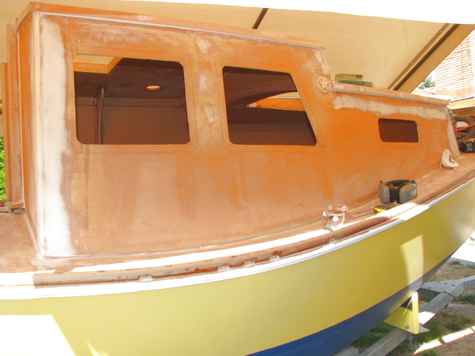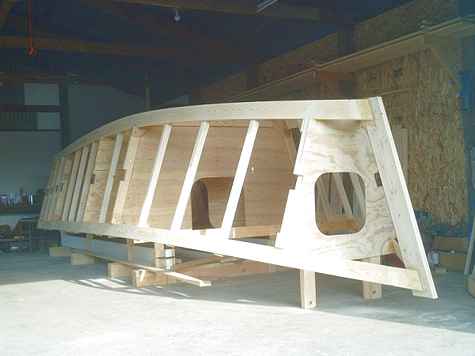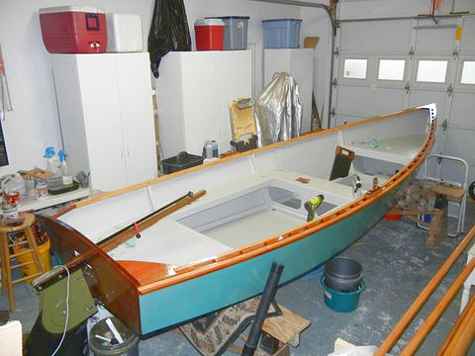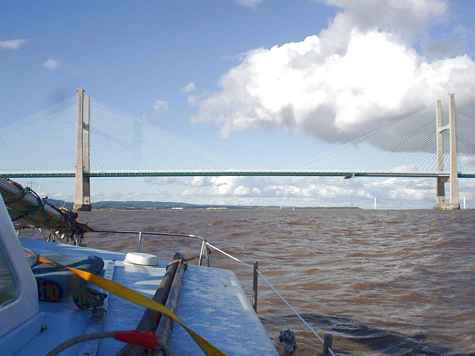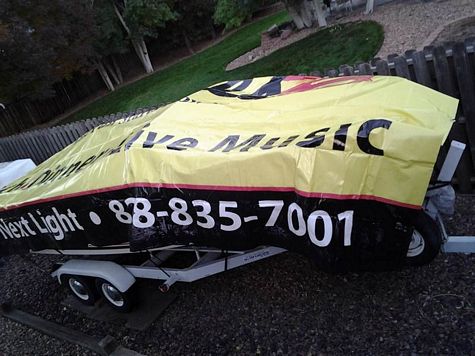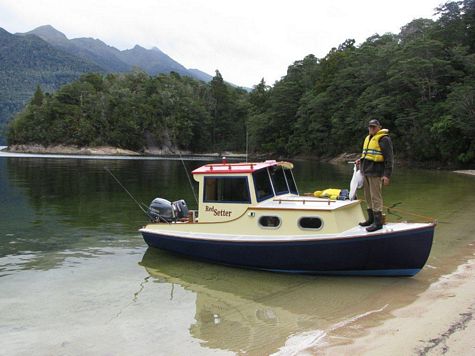
 Custom Search
|
|
| sails |
| plans |
| epoxy |
| rope/line |
| hardware |
| canoe/Kayak |
| sailmaking |
| materials |
| models |
| media |
| tools |
| gear |
 |
 |
| join |
| home |
| indexes |
| classifieds |
| calendar |
| archives |
| about |
| links |
| Join Duckworks Get free newsletter Comment on articles CLICK HERE |
|
|
| November Reports |
Send
items to chuck.leinweber@gmail.com for inclusion here next month. |
Book Review - Cruises with Kathleen
Donald Hamilton didn't build his boat. He didn't sail it across any oceans (although he did make some nifty trips). He didn't battle through any monumental storms. What he did is write a thoroughly enjoyable book about the process of selecting his boat, moving it across a continent, and then some cruises he took from the boat's new home base. Cruises with Kathleen was published in 1980 and is out of print, so if you want to sample its various pleasures, you'll have to dig it up from a secondhand source. (I did find it offered on Amazon.) It will be worth the effort.
The charm of the book is that Hamilton didn't do the things that might seem a prerequisite for writing a sailing book; heroic passages or battling epic storms and the like. Rather he did things that are attainable for a great swath of people who don't have the skills to build a boat or the time to undertake a trip around the world or across an ocean. That's not to say he only daysailed from harbor to harbor; he and his son did a 1,000 mile trip from Canada to Los Angles and he singlehanded Kathleen down the Florida coast in a series of day and overnight sails. (It's not part of the book but it is mentioned that he and his son also participated in the double handed part of the Bermuda One-Two race.) He directly attacks the reservations (typically fears of sailing offshore, sailing at night, and sailing alone) that keep people from doing these attainable adventures. Hamilton takes delight in revealing the joys of doing them. I expect most of the folks who read this review are like me. They have homebuilt boats that are intended for daysailing, camp cruising, and the like. That's okay. It's the spirit of Hamilton's book that still makes it a worthwhile read and regardless of what you sail, you'll come out at the other end a much more knowledgeable mariner. Scale the lessons up or down to suit your craft. The book is well written. Hamilton, who died at age 90 in 2006, was a professional author. He wrote everything from westerns to adventure novels, with his best known being the Matt Helm series of spy books. (The 1960s Dean Martin movies were loosely based on those books, the operative word being loosely.) Hamilton had been away from serious sailing for 20 years or more when he decided in the 1970s to give up his twin-outboard fishing boat and return to the world of keels, masts, and flapping canvas. The book is a loose narrative of choosing Kathleen (a 27-foot fiberglass, full keeled cutter) and the various kind of voyaging necessary to move it from the Pacific Northwest, where Kathleen was built, to the boat's permanent berth in The Florida Keys, plus some trips from there. The storyline permits Hamilton to relate a variety of boat locomotions, from ocean trips to ditch crawling in the Texas Intracoastal waterway in a frigid winter while dodging tugs and barges. Hamilton may not have crossed any oceans, but there are some notable passages here. Interestingly, a couple of my favorite chapters remain some of the more modest attainments. One is the trip he made with his son from Vancouver to the U. S. to register and document his new boat. It was a series of day trips where they tied up at docks every night. But Kathleen hit a variety of conditions, enabling her new owner to learn what kind of boat he had - everything from flat calms to ferocious headwinds to nasty tidal rips. The second is Hamilton's account of moving Kathleen singlehanded along Florida's Panhandle and down the state's west coast, featuring a couple of overnight passages. They show a skipper at home with his boat and executing a seamanlike trip. Interspersed in the journey are some reflective chapters, on sailing in general, on the joys and demands of singlehanded sailing, and a chapter on the seaworthiness of boats that ought to be required reading for anyone going afloat. After reading that chapter, you'll look at the boats differently next time you stroll down the docks at a marina. And it will put your own skills in perspective. Hamilton notes while he's never been through an ultimate storm offshore. In his earlier sailing days he encountered a number of nasty coastal squalls, including some with hurricane force winds. He survived (others didn't) because he was on seaworthy boats. "I'm grateful for those rugged experiences," Hamilton wrote. "They cured me of the foolish notion that I was a hell of a sailor who could survive any old weather in practically any old craft." A lesson by itself worth the price of the book. Hamilton added five appendices, some of which might be dated by the passage of 32 years since the book was published, but which I still find enjoyable. They cover nautical books (on cruising yarns Hamilton has a simple two question test: 1) Does the author enjoy sailing? and 2) Is he fond of his boat?); using a sextant; the necessity of having tools; self steering; and seamanship (this one is definitely not outdated). In that latter chapter, Hamilton worries that there is too much concern with safety instead of seamanship, which he defines as "to take a boat out smartly, sail it well, bring it back smartly, and leave it shipshape, having a lot of fun in the process." Teach seamanship instead of preaching safety and the safety will take care of itself, is his advice. Like other views in this book, it's sound counsel. And if you read Cruises with Kathleen, your seamanship will be improved. By Gary and Helen Blankenship © 2012 Windows Roughed In
One side of windows roughed in... The other side to do. Other work happening at same time. Rushing into fall... Richard Green TugShe is based on a big Pacific power dory hull & a tugboat type cabin. In my videos on design I explain how I came to this design. She is of my own design & was strictly experimental however she has proven herself on the water. In July we rode out an extremely fierce storm with 70 mph winds.
The idea for the Jani J began many years ago. I have always loved tug boats & building things. She was to be a multi-purpose vehicle for expeditions of adventure and exploration on rivers, lakes, islands and shorelines. She must be trailerable but large enough for 2 to live aboard comfortably on the water or her trailer. Shallow draft and beachable. Her hull is based on a large Pacific power dory. I drew several sets of plans and built 2 scale models to test the design. In 2005 my wife, Janice Jeanette and I started building in our shop in Whitewood, South Dakota. We made parts during the cold Winters for assembly, gluing and fiberglassing when the weather warmed in the Spring. She is 25 ft long, 8ft 3in of beam. The forward cabin holds a triangular queen seized berth. The pilothouse is raised with a 36 gal water tank and 4 batteries which serve as ballast. From the pilothouse you step down into the aft cabin. To port is a dinette that converts to a berth. To starboard is a sink with refrigerator under a stove area next, and a head/shower area. There is 5ft of aft deck. We launched her in July of 2011 at Belle Fourche Reservoir, South Dakota, And have made 3 voyages on Belle Fourche Res. and one on Lake Pactola in the Black Hills. We have plans to go to the Missouri River and out to an Ocean, as we can trailer her wherever we want. She has ridden out 2 bad storms and we have much confidence in her. She is just the greatest boat and we love her very much. Watch some videos of the build. Janice and Martin Houston Raleigh
Say, if your interested in building and sailing in and around Raleigh, NC - here is an invite to join the Raleigh, NC group for local building and sailing support: https://groups.yahoo.com/group/TSCRaleigh/ Especially for boat designs from this site - which are many! Boat Beacon
AIS is becoming more and more popular on coastal and inland waterways. I wonder if your readers would be interested in our new iPhone and Android AIS app, Boat Beacon, which allows users to see other boats via AIS and report their own boats position to Internet based AIS systems and other Boat Beacon users without the need for an AIS receiver or Transponder. It is specifically designed for use on the water, uniquely providing Bearing, Range and Closest Point of Approach (CPA) calculations in addition to the standard AIS information. It uses up to the second AIS feeds unlike the other AIS apps which can be a minute or even more behind real time. I have written a brief article about how I came to write Boat Beacon for my own use which may be of interest too. Steve Bennett Kayak Train
It's official, this Saturdays kayak train will be a new world record. The old record of 17 boats will be eclipsed this week and a new record will go in the books. Top officials from the "International Briggs and Stratton powered old timey African Queen type boats towing a string of kayaks and canoes" Association will be on hand to verify results and document the record. President "Crazy" Steve will be operating the tow boat while President Dave will observe for irregularities and President Stan the Man will bring up the rear to stop cheating. We are expecting a good turnout so when you get here be prepared to get your boat in the water and car out of the way fast. We'll have lines to tie the boats together so when I give the word get your kayak close to the beach so I can tie them together and get the string going. Once you are tied on you cannot untie yourself so go pee before you get in. Be ready to go, don't expect anyone to help you get yourself together; no exceptions except for foxy wives (like mine) or hot babes in tiny swim suits (like Stan's girls). Be ready to go by 10 or you can hang out in the shop or tiki hut or hammock till we get back. These shots are of another train we were on out of Crystal River. We went all the way out the river, through the marsh to the gulf and back; something you'd never do if you had to paddle. I see by the umbrella that Stan was with us, not a bad idea for this one if you don't like too much sun. *****
I promised you a world record kayak train and here it is. We had 28 boats tied together behind Chelsea. It was a great day and something we'll talk about for a while. Ernie and Donna were in Beauty Berry the safety boat and had to rescue two fall outs on the way back home, I think the beer may have gotten to them. This doesn't need much comment except how we got this long train hooked up and off the beach. You'll see in some of the early pictures a guy walking out across the lagoon; that's me. I started with the first boat and started walking out into the wind and as they came off the beach the next one was tied on. It worked very well, the line was pretty easy to pull. We figure that this train of boats was about 750 feet long. I made it out to the sand bar where I tied on to Chelsea with Steve and Lenna and the dogs inside. I waited on the bar for my kayak to come by; some of the gang gave me beers for my effort. I've cut out a lot of the pictures for this e mail but you can see more if you click on Lenna's link below. I'll send another installment next with more from another angle. https://www.blipfoto.com/entry/2393503 In the middle of the paragraph there's a light yellow "click for more pictures" do it and you'll see them all. David Lucas Lucas Boatworks and Happy Hour Club Folding Goose?Is this the latest boat design? Stan Repurposing
As you can see, “repurposing” makes sense both economically and environmentally. Our company – www.repurposedmaterialsinc.com – is focused on the creative re-use side of the famous three-sidedreduce, re-use, recycle arrowed triangle. repurposedMATERIALS is the only company in America whose entire product line is made of “repurposed” items. What is “repurposing”? Re·pur·posed Ma·te·ri·als (noun) Used assets that have value “as is” to a second, unrelated industry. (See fun examples below) Repurposing IS creative Reuse. It is NOT recycling that has gotten all the buzz since the 1970s. Remember, recycling requires huge amounts of energy to melt, grind, chip, or shred a waste stream into a useable raw material to manufacture something new. With “repurposing”, we deal with byproducts and waste that get a second life because they have value “as is”. So, what are examples of “repurposing”? Used rubber roofing membrane gets “repurposed” as pond liners… Retired wine barrels get “repurposed” as trash cans… Old street sweeper brushes get “repurposed” as back scratchers for livestock. Amy Duncan My BoatsRed Setter is a Hartely TS18 I finished in 2006. She is a lovely good natured boat. Pictured on Lake Manapouri. That is a good sized trout in the bag.
Yellow and blue boat is one I saved from the chainsaw. It was built by a friend's Grandfather, was lost from the family for 40 years and bought back in a bad state. When I got her there was no decking or superstructure and quite a lot of rot in the hull. Thank heavens for epoxy wood preserver. Relaunched in January and goes really well. My mate is delirious with her. Name of the boat is Airini. Around the Boatshop Oct 2012
This picture seems to sum it up about all of us, you may have to think about it a little. I bet your wife will agree with it. Or maybe we grew up and are now regressing. David Lucas https://flseagrant.ifas.ufl.edu/newsletter/#.UIStscWTxX1 https://www.marinetraffic.com/ais/ Lucas Boatworks and Happy Hour Club Columbia 150-ish PlanningHere's a rough guess at a schedule - mileage is estimated, it's close, but depending on your route, it can vary by a few miles. The downriver flow is usually a knot or so near Portland. I'd be interested in hearing your ideas as well. Staging Day, Sunday, Aug 4: I am currently thinking of making the staging area Sand Island near St. Helens. Good access to a boat ramp, to get there from either Fred's or that primitive launch on the downriver side of Caterpillar Island as well. Upriver First Andrew Linn New Title From International MarineTHE BOAT GALLEY COOKBOOK: 800 Everyday Recipes and Essential Tips for Cooking Aboard The ONLY comprehensive guide containing all the information on galley set-up, provisioning, cooking, and other food storage and preparation information needed aboard a cruising boat! Authors Carolyn Shearlock and Jan Irons are the Julia Child and Simone Beck of the galley. Just as Child and Beck made French cooking accessible, Carolyn and Jan make the challenges of cooking in a galley disappear. THE BOAT GALLEY COOKBOOK (October, 2012) is a comprehensive guide to cooking techniques, food storage, provisioning, and substitution combined with over 800 everyday recipes all designed for use on board in popular cruising grounds where convenience foods and electric kitchen tools are not available. The book includes: · 800 delicious recipes from scratch, all to be made by hand, without electric mixers · Includes a stroll through a Mercado- a South American market-- so you will know what to expect when provisioning in foreign countries · Recipes tested and improved by two galley cooking masters, both of whom blog and publish regularly · Includes a chapter of substitutions for making do when your galley is running low on key ingredients · Written in a casual, friendly tone with easily understood instructions · Uses unique, resourceful techniques not found elsewhere, including ThermosT cooking! The Boat Galley Cookbook October, 2012; Paperback, $36.00 Other New Titles: · Intracoastal Waterway Chartbook: Norfolk, Virginia to Miami, Florida by John and Leslie Kettlewell - Spiralbound, $75., Sixth Edition, fully updated (August, 2012) · Cruising the Chesapeake: A Gunkholer's Guide by William Shellengerger - Hardcover, $45.00, Fourth Edition (October, 2012) · Voyaging Under Power by Robert P. Beebe and Denis Umstot - Hardcover, $40.00, Fourth Edition (December, 2012) Questions? Comments? Books you'd like us to publish? Join the Conversation at www.facebook.com/InternationalMarine. |

